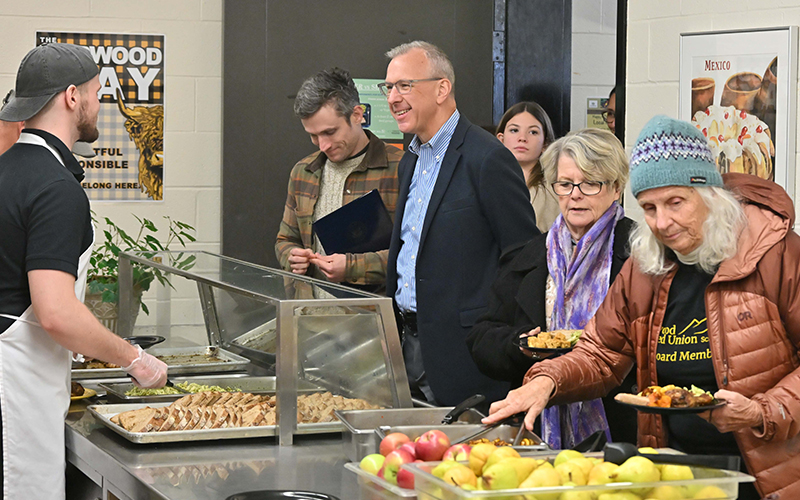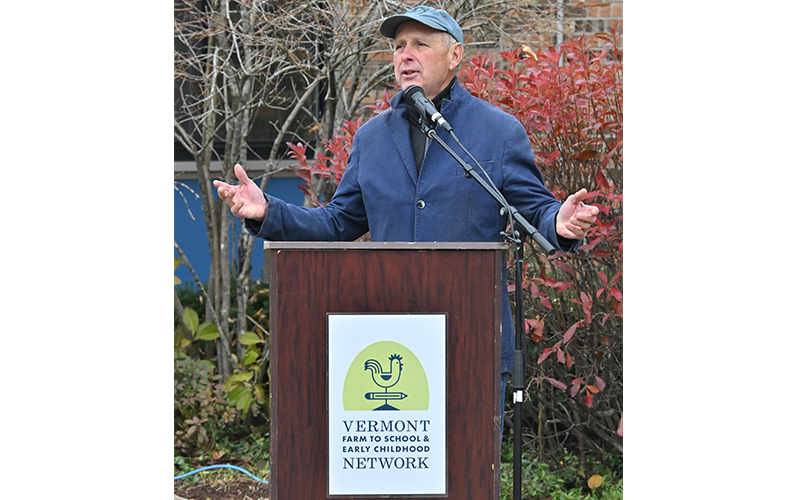Photos by Gordon Miller
Two hours out of each of Harwood’s seven-hour school days are dedicated to lunch blocks. The kitchen staff spends hours planning, preparing, and serving these meals. Much of the planning involves coordinating with local farmers, as 25% of Harwood’s lunches are locally sourced. To commemorate this, the Vermont Farm to School & Early Childhood Network held a November 7 event celebrating Harwood’s commitments to sustainability and connections with local food systems.
Four groups of students from the district were invited to present their contributions to this effort, representing Harwood’s National Honor Society, Sustainability Club, Developing Sustainable Habits (DSH) class, and Crossett Brook Middle School’s Sustainability class.
National Honor Society presidents Cashel Higgins and Lessa Dreimiller spoke about the club’s newly-opened, donation-based food pantry, which is stocked with non-perishable food items, clothing, and hygiene items; and is a space for students to access what they need during the school day.
Sustainability Club members spoke about their efforts to revive the school’s greenhouse and gardens, their legislative advocacy efforts, and their recent conversation with Vermont state representative Candice White, D-Waitsfield. The club is combined with the school’s branch of the Youth Lobby, which focuses on amplifying student voices through political advocacy.
HARVEST OF THE MONTH
Current DSH students spoke about the class’s curriculum, which centers around the United Nation’s 17 Sustainable Development Goals, and their efforts to create locally-sourced dishes each month with the Harvest of the Month. Through highlighting one harvest each month, said Evelyn Andrus, a freshman, “our goal is that people learn how to incorporate local food. We hope that people are thinking about what they eat and where their food is coming from.” This month’s Harvest of the Month is apples, and they had apple crisp bites made with apples from Hall’s Orchard in Isle La Motte.
Three Crossett Brook seventh graders spoke about their class’s curriculum. Unlike the other clubs and classes, middle school sustainability classes are only taken for one trimester at a time. “The curriculum tries to build on itself,” said Kayla Henry, who has been teaching at Crossett Brook for six years. “It’s focusing on the natural world and our part in it and our communities.” Throughout the trimester, the seventh graders have been growing microgreens and taking care of the school’s chickens and bees.
FIVE-YEAR MARK
After the student presentations, several speeches were given from HUUSD staff members, representatives for state agencies, local business owners, and a student – Dana Hudson, the coordinator for the Vermont Farm to School & Early Childhood Network – started her speech by emphasizing the importance of Farm to School programs in schools and celebrating Vermont’s progress on incorporating local food into school lunches. “We’re coming up on the five-year mark of universal food in schools,” she said. “Thanks to this, 85,000 students have access to free breakfast and lunch.” Last year, Vermont schools had an average of 14% local ingredients in their meals, keeping 3.5 million dollars in the local economy. “Much of the success is due to the efforts that people are making,” said Hudson.
Dr. Mike Leichliter, the HUUSD superintendent, detailed his experiences with Farm to School programs during his move from Lancaster, Pennsylvania, to the Mad River Valley. In Lancaster County, the “garden spot of America,” he said, “We were never able to figure out how to bring local food into our cafeterias. Not long after I arrived at Harwood in 2022, I visited one of our elementary schools and met a kindergartener.” Leichliter, along with the kindergarten teacher, struggled to find a way to describe his job. When they settled on a description, the student said, “So he’s the keeper of the keys to the chicken coop!”

The description felt “very Vermont” to Leichliter, but demonstrated the progress that the Farm to School programs had made with student mindsets. “I am so impressed with the quality of food that we provide for our children,” he continued. “Harwood provides about 25% of local food in our meals, and that reflects not only the work of the kitchen staff but student work and advocacy.”
FAVORITE PART OF MIDDLE SCHOOL
Julia Wulff, a junior, spoke next, beginning her speech with, “I’ve been a part of this school district since preschool.” She chronicled her experiences with Farm to School programs throughout her educational career, saying, “My most vivid Brookside memory was from the 4 Winds program.” In this program, led by educators like Hudson, students would go outside; make butter, cheese, and ice cream; and learn about farms and farming. At Crossett Brook, Wulff learned about food, farming, and climate change in Sustainability: “It was my favorite part of middle school. So, for my eighth-grade inquiry project, it seemed natural that I’d do something Farm to School-related.”
Wulff led the push to apply for a grant to keep beehives at Crossett Brook, “enhancing the curriculum that I’d always loved.” In high school, she wanted to continue her experiences. She joined the Sustainability club, where they used the greenhouses to grow ingredients for the school kitchens; and Youth Lobby, where she led a workshop at the FEAST Youth Summit. “I have become more knowledgeable and engaged in the world around me. I’ve never had to worry about not knowing what’s in school lunches, about mystery meat and overcooked broccoli.”
Erika Dolan, the HUUSD Food and Nutrition director, piggybacked off Wulff’s ideas, saying, “Our district is proof that local food incentive programs work.” Local purchases in the district grew from 14% to 23% thanks to incentives and universal school meal programs, “benefitting local economies but, most importantly, students. This shows what’s possible when we invest in Vermont values.”
Also speaking were two local business owners, Randy George of Red Hen and George Schenk of American Flatbread. Both spoke of their business’s investments in utilizing local ingredients: Red Hen notably worked with local farmers to develop a bread recipe aligning with Obama-era school meal regulations that is now used in many Harwood school lunches. “What’s more powerful than knowing where your food came from?” asked George. “Knowing this makes us, and our students, better citizens.”

Schenk spoke of the role of food systems in maintaining community health, citing Ancient Greek philosopher Democritus’s view that “happiness is the highest human achievement. Fundamental to that happiness is human health, and fundamental to that health is the health of our environment and the food we eat.” Bringing local foods into schools, he said, is “a tangible example of our commitment to children’s health. It’s an investment into the people we hold most dear.”
KEEPING LOCAL FOODS IN SCHOOLS
James McNerney, the field representative for Senator Peter Welch, spoke on behalf of the senator, who was at the Capitol for a vote to end the government shutdown. He read a letter from Senator Welch, which stated that events like this “showcase not just the aptitude and skill of students but the intrinsic value of keeping local foods in schools.” Welch recognized that October was Farm to School month, but that the “importance goes beyond one month.”
Welch’s letter detailed the bipartisan bill that he reintroduced in the Senate, along with senators from Maine and Delaware, titled the Farm to School Act. The bill aims to expand Farm to School program funding, reduce barriers to applying to grants, and expand the program’s education to preschoolers.
Dr. Rick Hildebrant, Commissioner for the Vermont Department of Health, and Anson Tebbetts, Secretary of the Vermont Agency of Agriculture, were the final speakers. Dr. Hildebrant detailed the medical importance of knowing what’s in the food that we eat, saying, “It’s so important to actively decide what we put in our mouths each day.” Secretary Tebbetts detailed the role that good lunches play in making students ready to learn, saying that investing in local food is “investing in our schools, our child care centers, and our farmers. Farmers make Vermont a healthier, stronger place.”
You might also like













